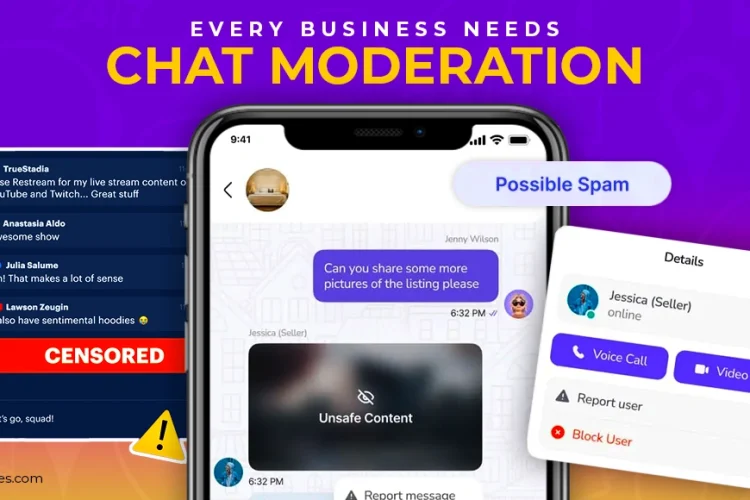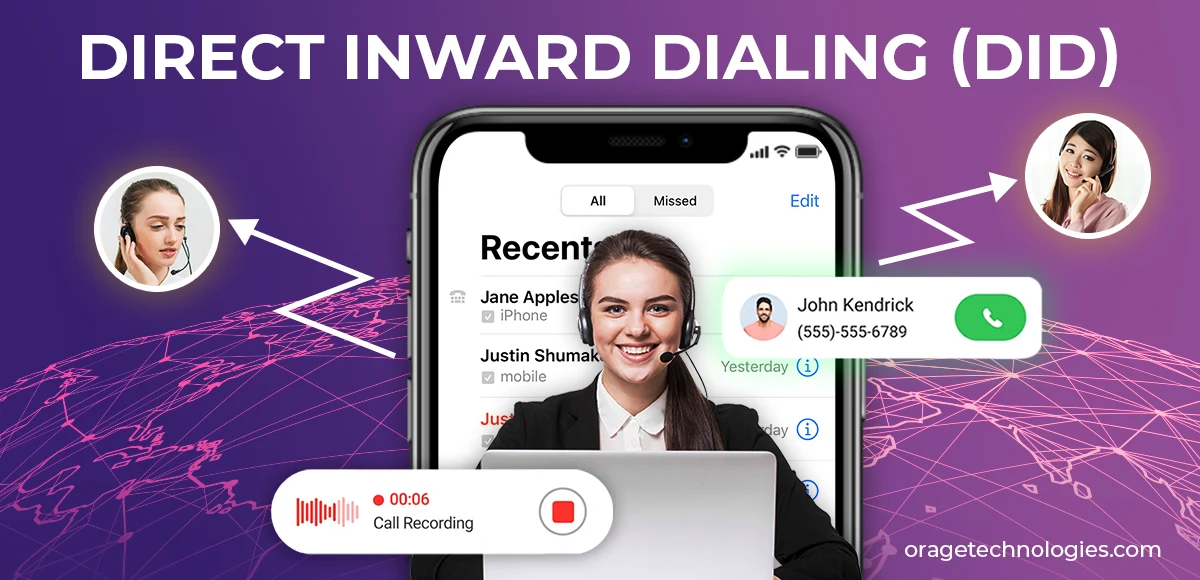
Divya Stuti, with over 5 years of experience in Digital Marketing & Content Writing, has a knack for turning complex Marketing strategies, trends, and jargon...
Direct Inward Dialing or DID has proven to be a revolutionary technology for businesses. It simplifies calls by eliminating the need for call forwarding, waiting, a receptionist, and confusion. This connects the call to the responsible person of the right department directly.
It offers direct numbers for every department, improving response time, efficiency, and ultimately customer service. Businesses are increasingly adopting DID either as a scaling tool or simply to improve communication.
What is Direct Inward Dialing?
Direct Inward Dialing, also known as DDI, direct-dial numbers, direct dial, and direct dial-ins. It is a networking technology where a block of telephone numbers is connected to the company’s Private Branch Exchange (PBX). This creates virtual phone numbers, bypassing the reception and directly connecting to a desk extension or group of extensions.
It can be used with local, premium-rate, or even toll-free numbers. DID helps businesses offer a more personal and efficient phone experience.
Also Read: Voice Process Means in BPO 2025: Complete Guide Along with Types & Benefits
What is a DID Number?
A DID number is a special kind of phone number that allows you to dial someone directly to his/her extension within an organization. It does away with the requirement for a receptionist, mainline, or auto-attendant.
Although it appears to be an ordinary phone number, a Direct Inward Dialing number is more similar to a shortcut to a person or a department. By calling the number, customers will go straight to the right person, bypassing the need to subscribe to the phone tree.
How Direct Inward Dialing Works in 2025?
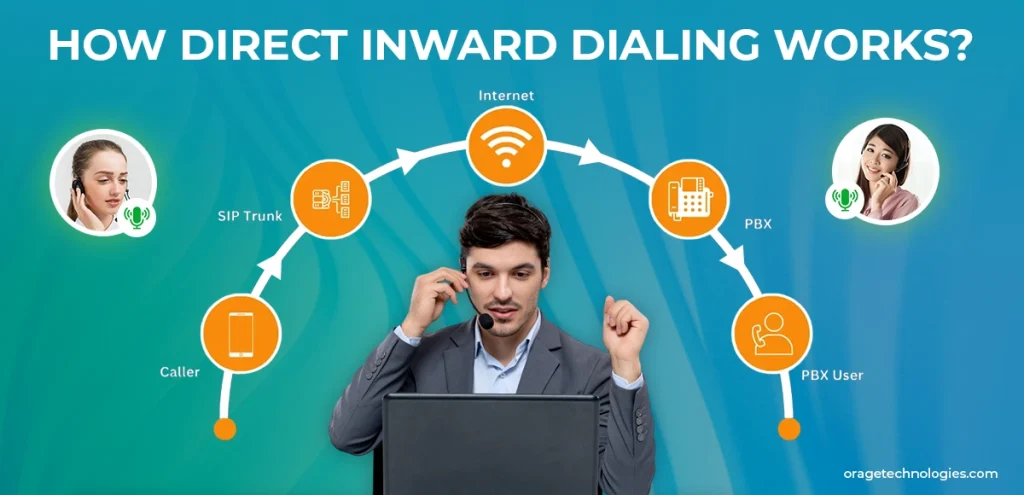
DID systems operated with either conventional phone lines (PSTN) or with VoIP (Voice over Internet Protocol). Most modern businesses opt for VoIP in 2025 because it is cheaper, easier to scale, and more flexible.
With VoIP, they employed DID telecom providers that, with SIP (Session Initiation Protocol) trunking, assigned virtual phone numbers. These trunk lines are not tangible wiring but instead, digital connections that rely on your internet.
DID Number Example
The DID service provider offers a stack of virtual numbers on the VoIP system. Now these numbers are set to specific places and users. After the setup, the VoIP system helps direct calls to the designated user.
For instance, a business from New York could give an MFA DID number to a sales representative. Hence, clients from a Florida region will receive a local number, yet the call is passed across the internet to New York. This configuration is beneficial in terms of global reach, local presence, and ease of control.
Types of Direct Inward Dialing (DID) Phone Numbers
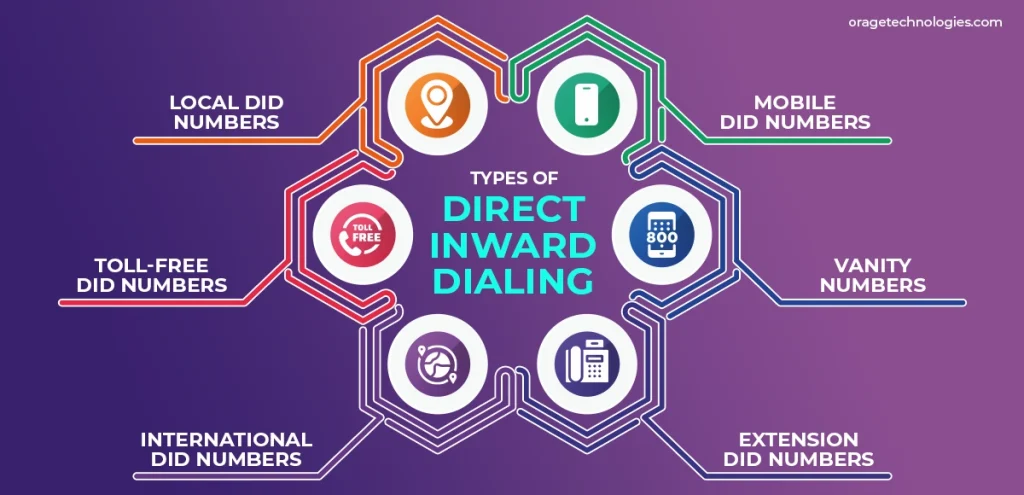
Businesses have a variety of Direct Inward Dialing numbers, depending on their requirements. Here are some of the popularly used DID Numbers are listed below:
Local DID Numbers
These figures correspond to the area code of a given city/region. Companies utilize them to create local trust and presence.
Toll-Free DID Numbers
These numbers are free for customers. They are ideal for support lines, sales forces, or national service offerings.
International DID Numbers
These enable global customers to contact at a local rate. A business in the U.S. can have a London number for UK clients, for example.
Mobile DID Numbers
This type of Direct Inward Dialing number is used to route directly to mobile phones. Hybrid work mode employees don’t need to share their private numbers.
Vanity Numbers
The vanity numbers are personalized to remember them, for example, 1-800-FLOWERS. They are usually utilized in advertising or branding.
Extension DID Numbers
In bigger systems, the numbers permit callers to dial extensions to access specific departments or employees. Each type has a specific purpose, and you can use them to meet your business goals.
Also Read: Non-Voice Process Means in BPO 2025 – Complete Guide
Benefits of Direct Inward Dialing
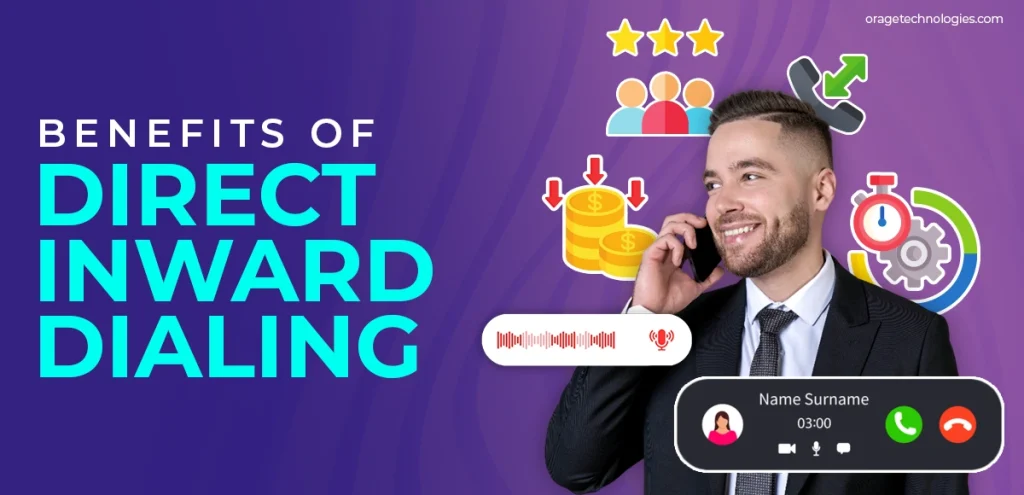
This is helpful to every type of business since it resolves most of the calling problems. Direct Inward Dialing offers a range of advantages to businesses. Some of the major benefits are given below:
Cost Savings
You’re not required to have a separate phone line for each extension. One SIP trunk can serve several DID numbers with great savings in costs. You are also able to evade the charges for long distances by using both local and international DID numbers.
Time Efficiency
A call directly goes to a person or a team, not manually routed. This saves time and increases efficiency.
Improved Customer Experience
Customers hate to wait or go through menus. A direct dial number provides them with easy and reliable access.
Enhanced Internal Communication
Employees can have direct calls with each other via internal DIDs even if they work from different offices or different countries.
Local Presence
Local telephone numbers are more trusted by clients and are more likely to be called. If your company has various branches in different cities or regions, you can choose to have a local DID number for different place. However, the different DID numbers will take the users to the right department even if that department is not in the customer’s local city.
No Need for New Hardware
VoIP-based DID is compatible with other existing phones or softphone apps. You don’t have to install new desk phones or complicated wiring.
Call Forwarding
In case a department is unavailable, DID numbers allow companies to use the call forwarding feature. The calls may get forwarded to a substitute department. Moreover, if the calls are unanswered, the customers can even leave voicemails. This prevents multiple people from interfering with receiving a call.
Flexible Scheduling
Calls can be routed differently depending on the time of day. For example, route all daytime calls to your US team only and all nighttime calls to your Asia support afterwards.
Marketing Campaign Tracking
Use unique DIDs for each marketing campaign and track which ones worked well to drive call and lead conversions.
Direct Inward Dialing Case Studies and Applications
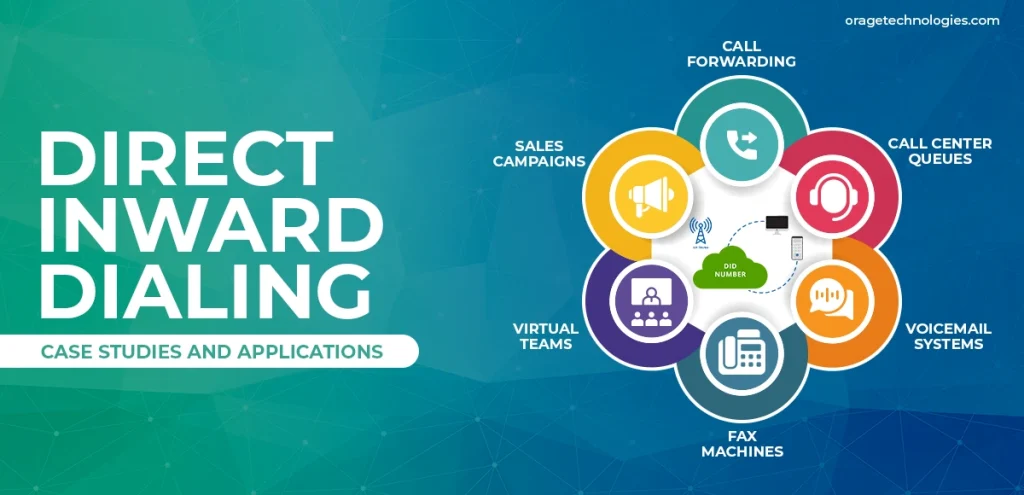
DID numbers are versatile, and businesses can use them in various cases. Some of the common applications of Direct Inward Dialing are listed below:
Call Forwarding
Redirect calls to phones on the move, remote offices, or international destinations. This is ideal for after-hours service or traveling staff.
Call Center Queues
Number your call center with several DIDs, and the calls are sent to agents depending on availability or department.
Voicemail Systems
It allows customers to leave messages on direct voicemail boxes attached to each DID number.
Fax Machines
DID for fax machines can allow incoming documents to be sent to the right destination.
Virtual Teams
It offers cohesiveness in the team even in a remote working environment via the use of the same phone system as DIDs.
Sales Campaigns
Separate DIDs can help companies track results and ROI for different campaigns.
Also Read: EasyShare: Complete Guide to Install And Use EasyShare APK 2025
How to Get a Direct Dial Number in 2025?
With modern telecommunications using VoIP systems, getting a normal Direct Inward Dialing number is as easy as pie.
- Select a VoIP Provider – Find experienced providers such as Twilio, Telnyx, Vonage, and VoIP.ms, Wavix, or Voxtelesys.
- Choose Number Type – Choose either local, toll-free, or international numbers as per your strategies.
- Port Existing Numbers (if needed) – If you already have numbers, you can port them over to your VoIP system.
- Assign Numbers to Users – Utilize the provider’s admin dashboard to assign a unique DID to an employee, extension, or department.
- Configure Routing Rules – Establish call forwarding, voicemail, and time-based routing rules.
As soon as deployed, your DID numbers will deliver smooth communication for internal teams and external customers as well.
Direct Inward Dialing Limitations and Fixes
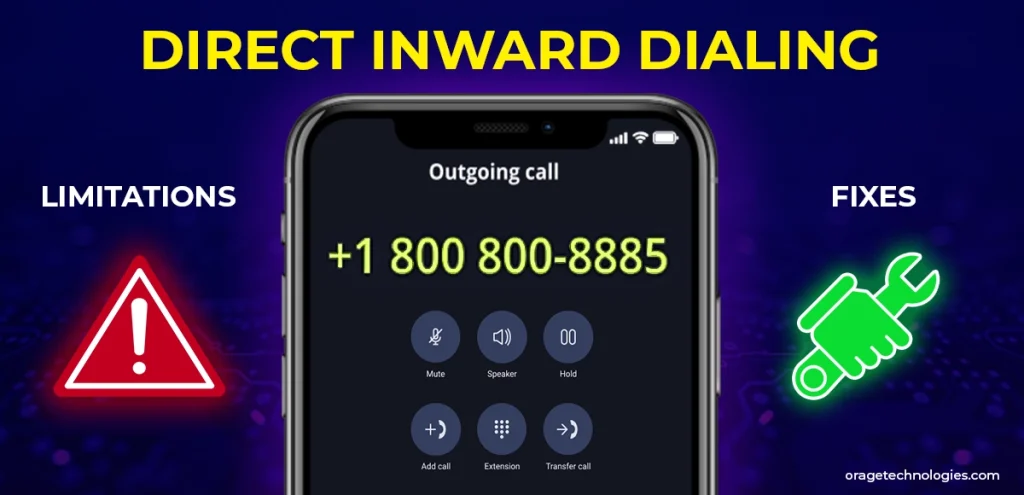
DID numbers are of great value, but there are a few challenges that you should get familiar with.
1. Number Availability
| Limitation: Popular area codes may not be easily available. |
| Fix: Select nearby codes or inquire from the provider for alternative recommendations. |
2. Scalability
| Limitation: Some providers can’t scale quickly. |
| Fix: Select a VoIP service provider that offers instant provision and management of numbers. |
3. Call Quality
| Limitation: Dropped or low-quality calls tend to occur if there is poor internet or misconfiguration of the systems. |
| Fix: Connect to a stable Internet connection and test call routing with the help of your provider. |
4. Compliance Issues
| Limitation: There are countries with strict rules on telecom services. |
| Fix: Deal with the one where the provider is observing local regulations and assists you in becoming compliant. |
5. High Costs
| Limitation: When DID costs are not tracked properly, they can pile up and prove to be costly for companies. |
| Fix: Bundle services together and keep checking how much you use to prevent overspending. |
6. Integration
| Limitation: Sometimes, the DID systems don’t integrate well with old hardware. |
| Fix: Use VoIP systems based on SIP, which integrates with new technologies. |
Difference Between Direct Inward Dialing and Direct Outward Dialing
Though they sound similar, DID and DOD serve opposite functions.
| Feature | Direct Inward Dialing (DID | Direct Outward Dialing (DOD) |
| Purpose | Receives calls | Makes calls |
| Call Direction | Incoming only | Outgoing only |
| Common Use | Businesses and call centers | Homes and basic business lines |
| User Control | Directs calls to specific users | Let users make external calls directly |
DID is all about receiving calls from specific people or teams. DOD is about making calls from a private extension to external numbers.
Conclusion
Direct Inward Dialing (DID) is a mighty instrument for enhancing communication within your business and with your customers. It eases your phone systems, reduces expenses, and gives the caller a more personal touch.
DID telecom solutions can help businesses stay connected, appear local, and scale fast. Choose the DID number that will work best for you, local, toll-free, mobile, or international, and equip your team with everything they need to.
Also Read: Chrome Net Internals DNS Tool – Complete 2025 Guide to Clear DNS Cache
FAQs
A Direct Inward Dialing (DID) number allows external callers to reach a specific internal extension without going through a receptionist or auto-attendant.
DID (used in the U.S.) and DDI (used in Europe) refer to the same feature, allowing direct calls to internal phone extensions via external numbers.
A SIP trunk is a virtual phone line using the Session Initiation Protocol (SIP) to enable voice over IP (VoIP) communication over the Internet.

Divya Stuti, with over 5 years of experience in Digital Marketing & Content Writing, has a knack for turning complex Marketing strategies, trends, and jargon into interesting and easy to digest blog posts. Whether she’s breaking down the SEO, Social Media or decoding campaigns, Divya knows how to make marketing feel exciting and easy to understand. Armed with a sharp eye for strategy and a storyteller’s instinct, she writes with clarity, creativity, and just the right dose of wit.
More Posts

